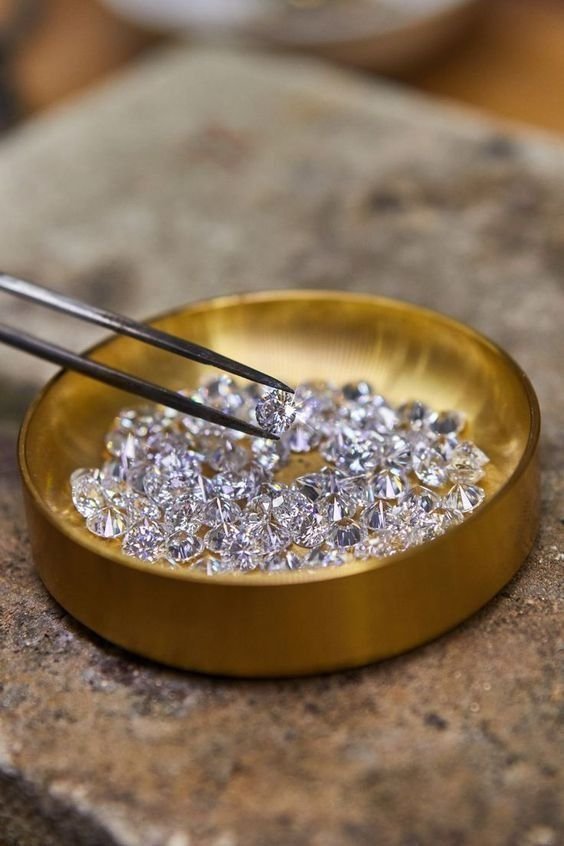
a short guide to everything you need to know about diamonds
DIAMOND 101
Diamonds have long been revered as one of the most exquisite and cherished minerals in the world, captivating hearts with their mesmerizing allure. Coveted for centuries, diamonds are renowned for their unmatched brilliance, exceptional durability, and rarity. However, their allure extends beyond mere visual appeal, as their physical and scientific characteristics contribute significantly to their unparalleled prestige and desirability.
Diamonds stand as timeless symbols of elegance and luxury, captivating admirers with their mesmerizing allure. Renowned for their unparalleled brilliance, durability, and beauty, diamonds embody prestige and desirability rooted in both their exceptional chemical and optical properties.
A RICH HISTORY AND ORIGIN
Originating from the Greek term ‘adamas’ meaning “indestructible”. Throughout history, diamonds have been symbols of wealth, power, and romance, often featured in royal regalia, engagement rings, and high jewelry. Their journey from deep within the Earth to dazzling centerpieces in jewelry pieces adds to their mystique and value.
INDUSTRIAL IMPORTANCE
Contrary to popular perception, diamonds serve as indispensable assets in various industrial sectors, particularly in drilling and cutting operations. A remarkable 80% of the global diamond supply is allocated to industrial applications, underscoring their substantial role beyond adornment. Industrial diamonds are essential for precision cutting, grinding, and drilling, making them vital to many technological and engineering processes.
UNIQUE COMPOSITION AND FORMATION
Diamonds are exceptional among minerals as they are composed solely of carbon, while most minerals are combinations of two or more elements. Diamonds are typically about 99.5% carbon, with the remaining 0.05% containing trace elements that can contribute to the beautiful fancy colors found in some diamonds, such as blue, pink, and yellow. These colours add to the diamond's allure and rarity.
Formed under extreme heat and pressure conditions deep within the Earth's mantle, diamonds are brought to the surface through volcanic eruptions, encased in volcanic rock called kimberlite. This arduous journey and the conditions required for their formation contribute to their rarity and value.
“A Diamond is forever”
DeBeers
One of the most iconic advertising slogans globally, this phrase carries multiple interpretations, symbolizing the timeless allure, icy beauty, and exceptional durability of diamonds. Durability signifies a gemstone’s capacity to endure wear, heat, and chemical exposure.
-
Diamonds rank 10 on the Mohs scale, which rates the hardness of gems and minerals. This scale dictates that only a mineral with a higher hardness rating can scratch another. Therefore, only a diamond can scratch another diamond. Although diamond is only one level above the corundum family (which includes gemstones like sapphires and rubies), it is significantly harder than these gems. Moreover, the Mohs scale does not account for how minerals interact with precious metals. Diamonds can easily scratch precious metals commonly used in jewelry settings, such as gold, silver, and platinum. Over time, a loose diamond in its setting can wear through the metal prongs, necessitating regular maintenance to prevent damage.
-
A gem’s toughness is determined by its structure, which is influenced by how diamonds form. Under intense temperature and pressure, atoms bond tightly in some directions and less tightly in others. These variations in bonding create cleavage directions, where diamonds are weakest and more prone to breakage. A sharp blow in these directions can cleave a diamond, even after cutting. Factors such as cut features and shape also affect a diamond's toughness. Diamonds with thin girdles are more susceptible to damage, and certain shapes, like pears and marquises, have vulnerable points that require careful setting to prevent breakage.
-
Diamonds are highly stable and resistant to changes and chemicals, making them virtually impervious to most acids. Even during the cutting process, which generates significant heat, diamonds typically remain intact. However, sudden and extreme temperature changes can pose a greater threat to their stability, potentially causing thermal shock that may create new fractures or cleavages, or worsen existing ones. With a combustion point of approximately 1562°F (850°C), diamonds can burn in scenarios such as house fires or exposure to jewelers' torches, resulting in a white and cloudy appearance. Attempts to clean burned diamonds often prove ineffective as the burn marks the diamond's surface, necessitating repolishing to restore its appearance. Fortunately, repolishing usually involves minimal weight loss and can be accomplished with relative ease.
THE FOUR C’S OF DIAMONDS
When evaluating diamonds, gemologists consider the Four Cs: Carat, Cut, Color, and Clarity. These criteria determine a diamond's quality and value.
At Naiad, we are committed to ethical sourcing practices. All our mined diamonds adhere to the Kimberley Process Certification Scheme, ensuring they are conflict-free and responsibly sourced. This international initiative prevents the trade of conflict diamonds, promoting transparency and ethical standards across the diamond supply chain.
In addition to mined diamonds, we offer lab-grown diamonds as an alternative. Lab-grown diamonds are cultivated in controlled laboratory environments using advanced technological processes that replicate the natural diamond-growing conditions. They offer near-identical chemical composition, optical characteristics, and durability as mined diamonds, providing an attractive option for those seeking the highest quality and larger carat sizes at a more accessible price point.
-
Refers to the weight of the diamond. Larger diamonds are rarer and more valuable
-
The precision of a diamond's cut affects its brilliance and sparkle. A well-cut diamond reflects light beautifully.
-
While many diamonds appear colourless, they can exhibit various hues. The less colour, the higher the value (this is only the case for colourless diamonds)
-
Measures the presence of internal or external imperfections. The fewer the inclusions or blemishes, the higher the clarity grade.
